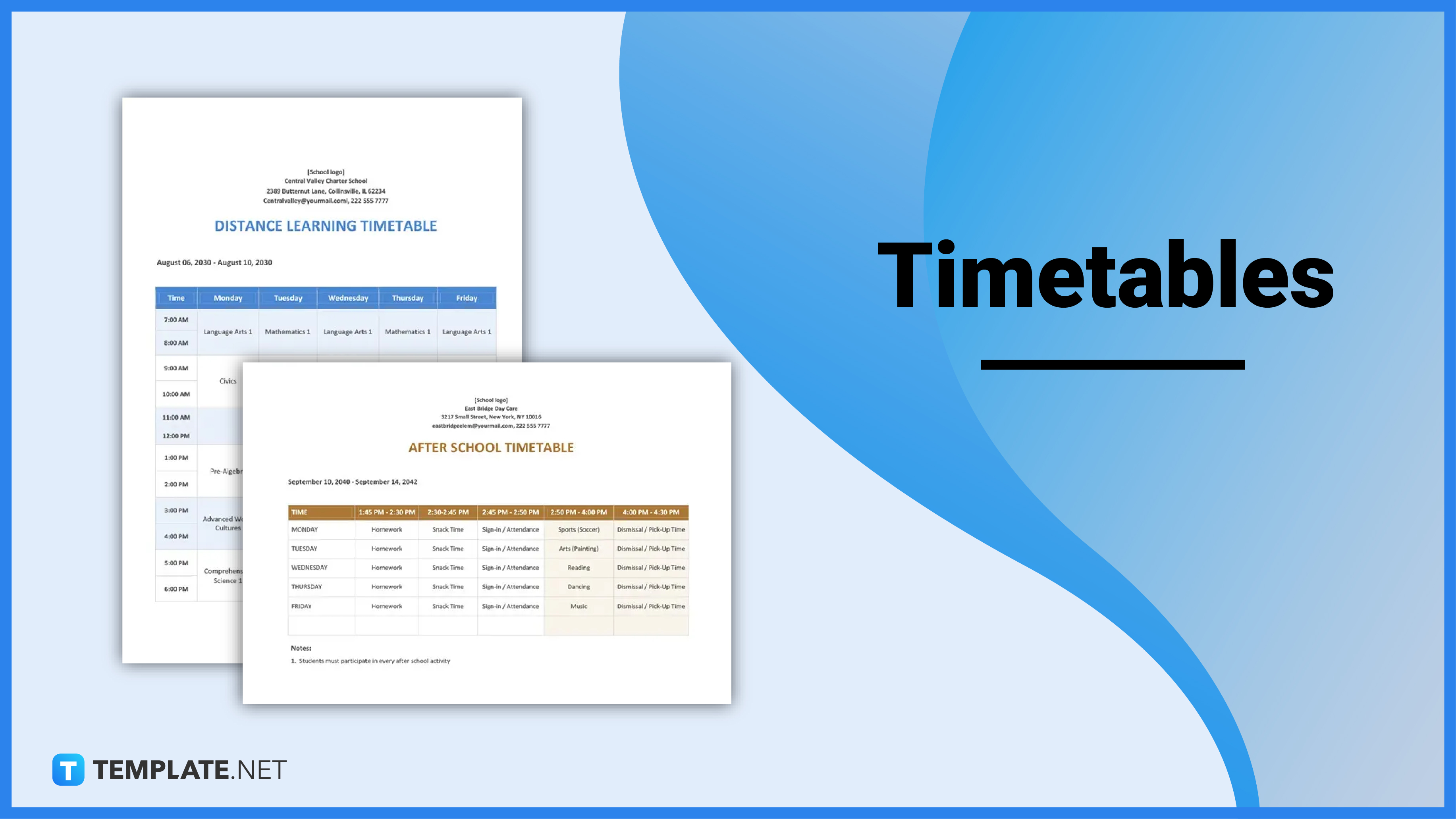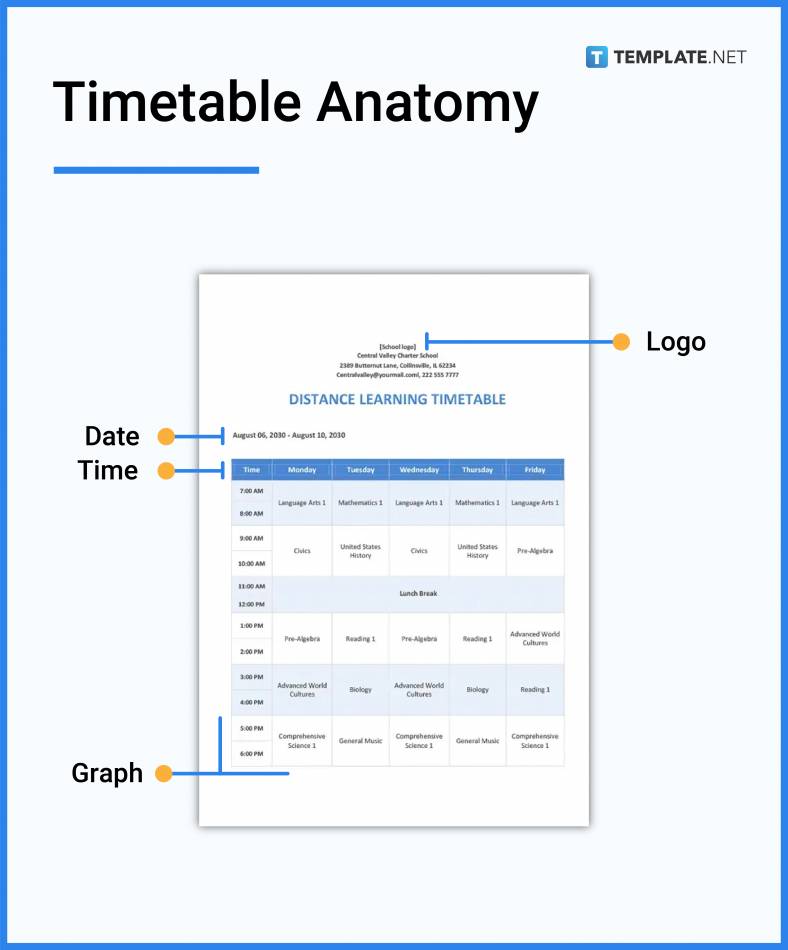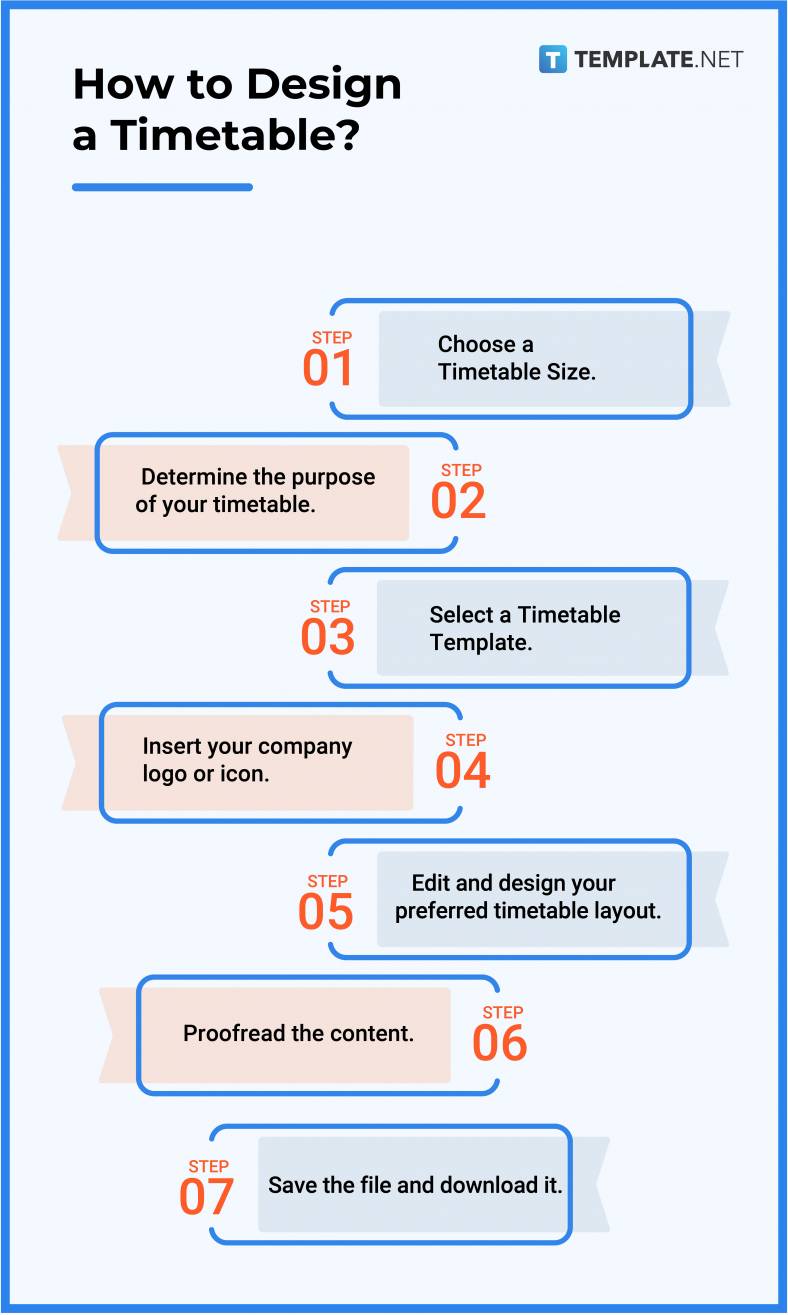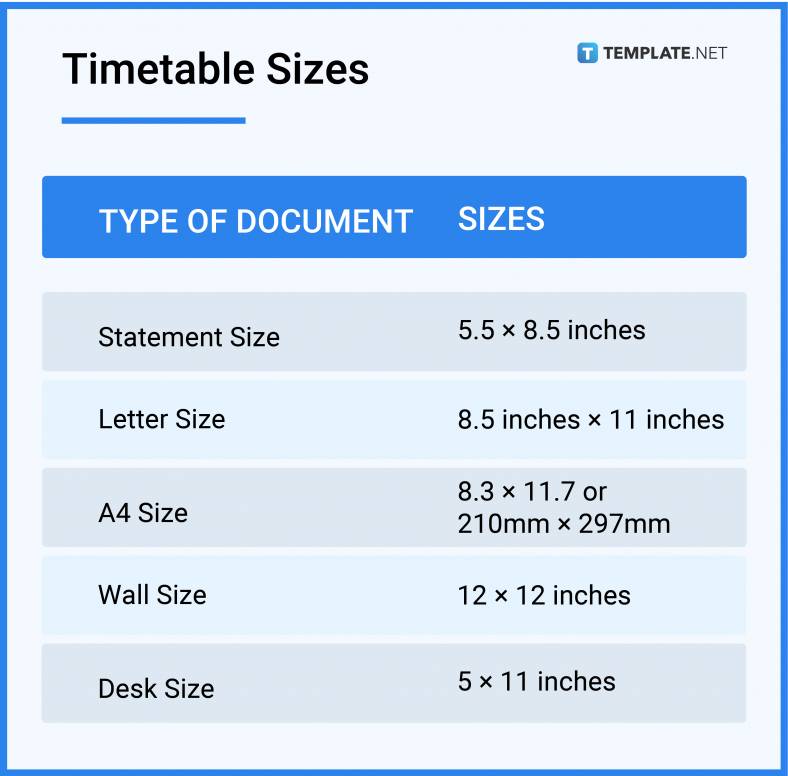![How To Create Meeting Minutes in Google Docs [Template + Example]](https://images.template.net/wp-content/uploads/2023/07/How-To-Make_Create-Meeting-Minutes-in-Google-Docs-Template-Example-788x443.png)
How To Create Meeting Minutes in Google Docs [Template + Example]
Meeting minutes Play a vital role in the recording of meeting information and details. In any kind of meeting, there is always…
Apr 22, 2023
Timetables are critical components in companies that showcase schedules, tasks, or project timelines. It has a significant role since it is usually displayed on walls where employees can see them automatically, which boosts meetings and communication.

A timetable is a document usually wider and larger in size that shows upcoming events and tasks schedules, allowing employees or timetable users to keep track of their routine.
Schools, offices, stores, etc., use timetables as their schedule and work trackers by putting or hanging them on a wall to deliver visibility to their audience to improve time management and to-do list processes.
A timetable is usually a chart that shows the schedules and project timelines of a company. It assists employees in not losing track and improving their daily routine, leading them to adjust to the overall schedule of the company. The timetable can also be a smaller version that employees print out to put in their cubicles to serve as reminders.
The school timetable is a schedule tracker for schools. It has tasks for children or students such as cleaners time, exams, projects, classes, etc. With this tool, students and teachers have a clear course or route.
A business can have multiple tasks within a week. In that case, since business processes and procedures can be a lot, they will be hard to remember. A weekly timetable is a tool important to businesses to show schedules, assuring overlooks avoidance.
Study timetable aids students in keeping track of their learning analysis, subjects, and schedule cycles. It is essential as it serves as a schedule visual for the kids. This situation allows them to grasp their school appointments.
As we all know, due to the global pandemic, authorities are forced to implement work-from-home arrangements. For this reason, most schools apply online classes where students and teachers connect through devices. A distance learning timetable is a critical piece in classes since it exhibits the subject cycle and class routine.
A lot of people prefer commuting when going to their schools or offices. A bus timetable is a document that shows the schedule of various bus and their routes. That way, transporters will know what time they should wait at the bus stations and what bus will come at specific times.
Important activities such as exams should never be taken for granted. A revision timetable helps you plan your revision activity time and calculate how much time you have before the big day. It assists you with time estimation, leading you to do what you need to do to reach your objectives.
In school, teachers or even working students make use of a class timetable. It helps them keep track of the subjects they need to teach on specific days and times. Having this type of timetable also aids them in reminding future events and other class factors.
An after school timetable is mostly perfect for kids, it shows their studying, snacking, and playing routine, helping guardians provide a healthy routine for their kids. Timetable supports them in improving time management. That way, parents or teachers ensures a joyful time.
Multiple industries require a timetable for their schedules. We have a blank timetable you can use depending on your preferences. By having one, you can edit, insert, or add your business contents and appointments.
Exams are always hectic even during the studying phase, it is always best to set aside time to prepare yourself mentally and emotionally for it. An exam timetable helps you understand and plan for the best exam date for your school. This timetable reminds and supports you from time confusion and overlooks.
Timetable plays a critical role in the professional industry. Although most companies or small businesses use digital tools or technology to keep track of their schedules, a physical timetable still delivers a significant contribution. Timetable, usually posted on walls or displayed on tables, allows users to see the schedules before turning on office devices. With this tool, users can access their schedules conveniently even without devices.
Since timetables are posted on walls or displayed on tables, you can easily see them. In addition, they usually have a bigger size than usual; you can read and review them even when you are at a particular distance. Employees who forgot their schedules or the company cycle can look at their walls or table to see their timeline presenting the information they need to know.
Using digital tools is convenient. However, having timetables ready and visible on walls allows you to read them before opening your computers, which is perfect for impromptu discussions. There are times when your devices are low on battery, leading you to require a hard copy for your timetable.
Timetable’s main purpose is to help you keep track of schedules. It allows you to know and be reminded of your upcoming tasks and appointments. A timetable exists for the purposes of presenting your appointments to aid you to improve your time management.
Timetable usually presents the schedules of various employees. In that case, it allows you to ensure your schedules are synchronized with your team, group, or department. Aside from that, timetables assist employees to know what to do and what times are available for a specific project.
Forecasting is crucial in the professional industry as it aids you in generating plans to improve business factors. As timetables show schedules in a day, month, or even year, it assists you in choosing the right time for more future meetings, events, and other critical activities. In addition, it aids in predicting possible events, resulting in you deciding on an improved timetable.
A company logo indicates your company’s identity. A logo is one of the most important parts of a document to know that a particular file or document belongs to your company, leading your employees to know that that is your planned timetable. This aspect also exhibits professionalism.
A timetable is for showing the schedule. Of course, it requires the time aspect. The time displays the figures to the users and viewers of the timetable, allowing them to understand the assignment.
A graph is a diagram, chart, or grid that factors the time out. It is made of sections such as boxes that indicate the schedule. Every box or column of the graph is labeled with days, weeks, or months, depending on the timetable if it is hourly, daily, weekly, monthly, or yearly.
The date is the time clock’s partner. Showing just the time leads to confusion and misunderstanding. The date, which presents the month, day, and year helps viewers understand the elements of the schedule or appointment.
Although time and date are enough to send the message, enabling space for notes is also helpful. Notes can help readers obtain further information such as the location, motif (for events), requirements, etc. That way, you can ensure that your readers acquire the critical data you need to convey to ensure overlook avoidance and insufficient announcement.

1. Choose a Timetable Size.
2. Determine the purpose of your timetable.
3. Select a Timetable Template.
4. Insert your company logo or icon.
5. Edit and design your preferred timetable layout.
6. Proofread the content.
7. Save the file and download it.

A timetable display high probable events that will happen in the future and the schedule of various employees or departments within a longer period such as a week, month, and year.
The schedule has a single focus which an individual use for their appointments and planned events that might not or will happen in the future.
A timetable shows the schedule of various departments/employees, regular events, and the planned schedule cycle of the company, leading to a daily harmonic routine.
A to-do list is a paper or document focusing on your planned tasks of the day, week, or month, which does not always include the time and date.
A planner’s objective is to help you generate strategic plans mostly without time and date certainty, as it can change depending on circumstances.
Various firms use or prefer different timetable sizes. There are different measurements or dimensions for timetable documents you can use for print, business, and academics.

Timetable ideas can be hard to generate. Timetable tools require innovative and creative layout and design to ensure engagement and deliver professionalism to your audience.
A timetable should have a date, time, title, company name, format, and design (images and clip art).
It depends on what part you are in the world since every part of the globe has a different timezone.
You can check your personalized timetable by accessing excel on computers or other devices if you use software/apps for your timetable or get your planners or schedule book to review your timetable.
School timetables influence the length of the school day, week, and year, the recommended contact period, subject counts, number of teachers, and the availability of facilities or classrooms.
The smart timetable is an online technology perfect for high school, college, or university as it helps students have a more convenient schedule tracker.
A good timetable delivers easy-to-understand content, provides informative details, shows the connection between tasks and people clearly, is versatile, and overall ensures lucidity.
The role of a timetable is a schedule generator that reminds and arranges tasks in a preferable and organized period.
Timetable optimizes time, aids lesson planning, assures a complete and organized curriculum, and separates tasks and class schedules effectively and efficiently.
A timetable is set with graphs, columns, and grids because it displays straightforward and manageable time, date, and description, leading readers to understand the content immediately.
Business timetables provide a big impact as it serves as the basis of company teams of their schedules, not just theirs but the overall company, resulting in synchronization.
Since the timetable shows a transparent and comprehensive schedule arrangement, It aids students in gaining a better insight and drive of their schedule, deadlines, and appointments.
Though devices are convenient, timetables still exist in companies since it is usually visible on walls and desk so that with one glance, you can gain informative details that save time and effort.
First, collect your task factors such as the date and time, choose your preferred app for digital documenting, select graphs or timetable templates, and write your schedules in the boxes in a correct order corresponding to your planned routine.
You can improve your daily habits by choosing a healthy routine such as waking up at the right time, eating meals in the proper cycle, exercising, working, drinking water at correct intervals, and sleeping at the right time.
![How To Create Meeting Minutes in Google Docs [Template + Example]](https://images.template.net/wp-content/uploads/2023/07/How-To-Make_Create-Meeting-Minutes-in-Google-Docs-Template-Example-788x443.png)
Meeting minutes Play a vital role in the recording of meeting information and details. In any kind of meeting, there is always…
![How To Make/Create a Manual in Google Docs [Templates + Examples] 2023](https://images.template.net/wp-content/uploads/2023/07/How-To-Make-Create-a-Manual-in-Google-Docs-788x443.png)
Manuals are essential instructional and reference guides. They help direct and inform an individual’s actions and also explain how to…
![How To Make/Create a Manual in Microsoft Word [Templates + Examples] 2023](https://images.template.net/wp-content/uploads/2023/07/How-To-Make-Create-a-Manual-in-Microsoft-Word-788x443.png)
Creating a manual can be a time-consuming and tedious task. However, manuals and other reference guides are necessary for organizations…
![How To Create a Legal Document in Google Docs [Template + Example]](https://images.template.net/wp-content/uploads/2023/07/How-To-Make_Create-a-Legal-Document-in-Google-Docs-Template-Example-2023-788x443.png)
When creating a legal document, there are a lot of things a person has to consider, and one of which is the…
![How To Make/Create a Contract in Microsoft Word [Template + Example] 2023](https://images.template.net/wp-content/uploads/2023/07/How-To-Make_Create-a-Contract-in-Microsoft-Word-Template-Example-2023-1-788x443.png)
Contracts can come in different forms and for different reasons but the most common thing is that when a company does business with…
![How To Create a Contract in Google Docs [Template + Example]](https://images.template.net/wp-content/uploads/2023/07/How-To-Make_Create-a-Contract-in-Google-Docs-Template-Example-2023-Step-788x443.png)
Contracts are an important part of any company or business, especially those that work with different companies or businesses. Companies…
![How To Make/Create a Report in Google Docs [Templates + Examples] 2023](https://images.template.net/wp-content/uploads/2023/07/How-To-Create-a-Report-in-Microsoft-Word-788x443.png)
A report is a comprehensive document that covers a wide array of topics from finance, research, incidents, feasibility studies, and…
![How To Make/Create a Report in Microsoft Word [Templates + Examples] 2023](https://images.template.net/wp-content/uploads/2023/07/How-To-Make_Create-a-Report-in-Microsoft-Word-Templates-Examples-20232-788x443.png)
A report is a document that contains information, data, analysis, finding, and other relevant information based on a specific topic.…
![How to Make/Create a Notebook in Google Docs [Templates + Examples] 2023](https://images.template.net/wp-content/uploads/2023/07/How-to-Make_Create-a-Notebook-in-Google-Docs-Templates-Examples-2023-788x443.png)
Notebooks always come in handy in writing important information or expressing our thoughts through written words. When we need a…